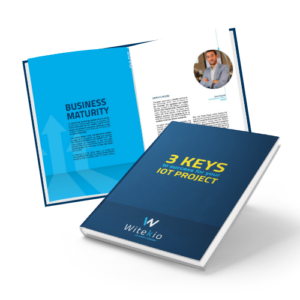Witekio’s latest white paper – How to Make Sure Your IoT Project is a Success – includes everything that you need to make sure your IoT project is planned, developed, and launched smoothly, efficiently, and with the greatest chance to make a market splash.
3 Key Success Factors for Your IoT Project
We outline all of those core questions that must be answered before an IoT project is launched in order to ensure that the right expectations are set, the right team established, and the right technologies selected.

Covering everything from use cases and the user experience to system security, feature roadmaps, and frontend technology choices, the white paper is a step-by-step guide to aligning your business, engineering, and sales teams around your IoT project. With case studies of successfully executed IoT projects from L’Oreal, Evoca, and Solvay and insights from Witekio’s founders, this is a must-have guide for any IoT development team seeking to start 2021 with success.
Success in an IoT project is not a matter of making one right decision. Instead, it is about making the right choices for your device and use case form initial conception to market delivery. Still, there are some broad areas where making the right choices and putting the right plans into place can generate real rewards; thus, from the pages of the new white paper, here are three key success factors for your IoT project.
1/ Assess Your Business Maturity
Business maturity in the sense of an IoT project is not about how long you’ve been a company nor how many IoT projects you’ve completed in the past. Instead, it is about an assessment of your understanding of the use case for your IoT device, the market for your IoT project, the competition in that market, and having a clear idea of the budget you’ll need to deliver the device you’ve imagined.
In making this assessment, key elements to consider are whether you use case is clearly and specifically defined or still very general – the former is better, the latter is a sign there is more planning to do. You need also consider the user experience that your IoT device will deliver, the interface you intend to use (touch, voice, keyboard), and whether your device will be wearable, handheld, fixed in place or mobile.
On the market side of things, you’ll want to have a clear idea of who your competitors are. This will require research as it’s very rare that a device or platform will arrive in a market devoid of all competition. Even in entirely new domains there will likely be a status quo option that can be cited as an indirect competitor, an alternative that you’ll have to spend time convincing users to switch from.
Finally, there are questions around budget. Hardware, software, and developer time all cost money, as do logistics, support, sales, and marketing. Successful IoT projects are able to set budgets for these business lines and more, and gauge from the outset the financial feasibility of the project.
2/ Understand Your Systems
The systems within and behind your IoT project are key to its success or failure. Get them right and you’ll be well-positioned to take a piece of the market; get the wrong and you might be lucky to even get to launch.
Your system architecture is the first concern. You need to architect a product that is useful, relevant, and scalable right across its expected lifetime. Achieving this means taking a system-level view and ensuring that you have the room to grow the breadth and depth of your offer over time. At the same time, you should consider the so-called ‘Go to Market’ challenges that arise from expanding a proof-of-concept IoT project to a fully-fledged, market ready device. Anticipating and responding to these challenges can make the difference between making a market splash and making an embarrassing bellyflop.
Successful IoT projects have roadmaps of the features and product versions prepared well in advance of launch. These roadmaps are a testament to the maturity of the development team that is aware of what the minimum requirements for a successful launch are, and what features might be added or updated later.
A final element that stands out as important when it comes to understanding the system is having clear insights into security concerns. IoT devices add enormous value to businesses and consumers through their capacity to collect, store, process, and transmit data. Securing this data is not only good busines it is also a legal and regulatory obligation. Successful IoT projects put security at the forefront of planning and devote resources to ensuring that it stays there.
3/ Master Your Technology
Mastering your technology means making the right choices about hardware, software, and embedded systems in order to meet the expectations of your users, your business team, and the market as a whole. Five areas in particular can be assessed to determine whether your team are truly masters of their IoT project technology.
First there’s the hardware choices you’ve made. Your hardware choices need to be made in light of the use case that you are addressing. If your device is going to be subjected to extremes of temperature, if it’s going to be carried and used throughout an entire 12-hour shift, or if it is going to be used underwater or in inclement weather, your hardware must be up to the task.
Second there is the importance of the embedded software features. Getting the firmware right and ensuring that it can be updated easily and without ‘bricking’ the device is essential, and choosing an appropriate operating system is a key choice for every IoT project, too.
Selecting the most appropriate hosting approach – either local, cloud, or a hybrid of the two – is a third consideration and having the appropriate and most effective frontend technologies for your associated business application is a fourth. In both cases your choices will impact performance and useability in a way that can make or break your IoT project.
Fifth and finally, you need to master the connectivity technologies that you have selected for your IoT project. Depending on the use case certain options might be better than others and you might even find a combination of connectivity options (Bluetooth and Wi-Fi, for example) might offer the sort of functionality that your team needs, and your users expect.
You might also like...

Tips on energy optimization in IoT - Low Power IoT Devices
Read more

